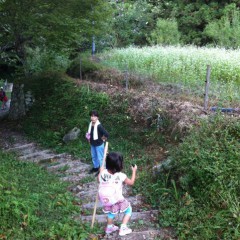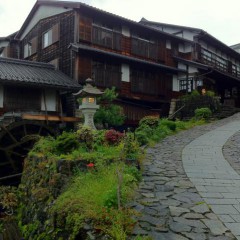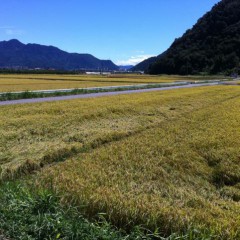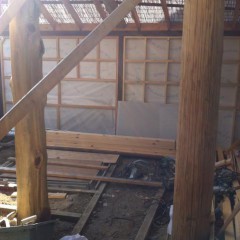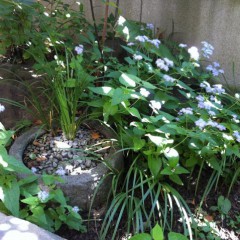江戸と京をつないだ中山道の長さは約534km。現在はその江戸時代からの面影が一番残っているのは馬籠と妻籠の間の8㎞の部分。従って、中山道を歩いてみたい方の中で、この部分は人気がある。
先日は我が家族がその8kmを歩いてみました。標高600mの馬籠から801m馬籠峠を越えて、420m妻籠まで。ガイドの本によると、途中で滝、森林、畑がある。
後は未知。
未知の道。
江戸時代からの道を通ると言ったら、色々と想像しました。来の裏に忍者が隠れているかとか。
未知の世界、想像の世界だからこそ楽しみは倍ぐらい。
実際歩いてみたら、第一印象は想像付かなかった事: 車の排気ガス。ガイドの本や観光のパンフに馬籠と妻籠の間の中山道の一部が県道7号の側、一部は県道実態に歩くって事があまり書いていなくて、その事実に少しがっかりでした。まあ、大半は車やバスの音が聞こえない森林の中や宿場の集落、畑を歩きましたから結果的に良かったです。
県道じゃない部分は想像通り、と言うか、想像より良かった。
馬籠峠の手前の集落の神社で地元の秋祭りだったので、祭り興奮の子供達がいたり、
畑で働いていたおばさんが声をかけて、お茶に誘ってくれたり、
峠を越えてしばらく歩いたら親切なおじさんのいるお茶屋で焼印付きの杖を買ったり、
花が咲いている蕎麦畑、
森林や滝の幻い自然、
妻籠に近づいたらイワナを育っている池があったり、
とにかく日本の地方の昔からの雰囲気、生活、自然、人などの良さ、そのまま。
最高に良い思い出になりました。
馬籠から妻籠の中山道。4歳の美咲ちゃんペースで3時間でした。
The Nakasendo is one of the 2 old roads that connected feudal Kyoto with Edo (the old name for Tokyo). Along its entire 534km length, the part that best retains the old Edo-era ambience is the 8km stretch between Magome post town in Gifu Prefecture and Tsumago post town in Nagano Prefecture. It is a popular hike for people interested in walking the Nakasendo trail, and the quintessential hike for visitors from overseas hoping to catch a glimpse of 'old Japan'.
The other day, our family took a trip and walked this section of the old Nakasendo. The guide books tell you to start at Magome (elevation 600m), cross the Magome Pass (801m) and descend to Tsumago (420m) and that you walk through a forest and pass waterfalls and fields along the way.
What they guide books and tourist brochures don't mention is that for a fair amount of the way, you'll also be sucking in car exhaust. It turns out a fair amount of the way is adjacent to, or actually on, County Road No. 7. Not that I expected to see a samurai trotting along or a ninja hidden on the side, but nor did I anticipate dodging a tour bus. Hence a not-so-impressive first impression.
On the other hand, the tour books also neglected to mention a handful of other areas, things that went way beyond my expectations:
*In between Magome post town and the pass, there is a quaint little hamlet. We passed through just as the local shrine's fall festival was finishing -- the young participants were literally bouncing down the road in excitement from the festival.
*A little old lady working in a field we went by on the way to the pass called out and invited us to tea.
*After crossing the pass, the path becomes considerably more woodsy and serene before coming to a single, old wooden building that serves as a teahouse to travellers, just as it did hundreds of years ago. The convivial old man running the place made us feel at home. We bought walking sticks there that he marked with a hot brand for us.
*Just below the teahouse was a soba (buckwheat) field -- in full bloom! The white blossoms contrasted so beautifully with the green trees in the background.
*As the path approaches Tsumago, it passes fish ponds where the locals raise iwana (char), as has been done for generations providing an important source of protein to the people in this area so deep in the mountains and far from the ocean.
Walking the Nakasendo from Magome to Tsumago was a magical trip back in time and a glimpse of the idyllic Japanese countryside.
The 8km walk took 3 hours at 4-year old Misaki's pace.
